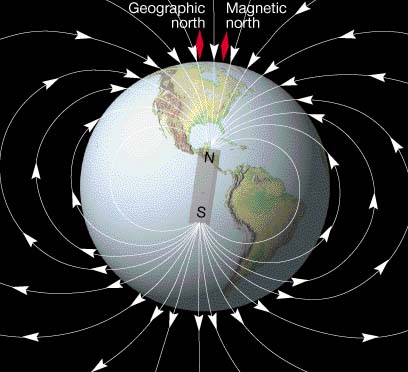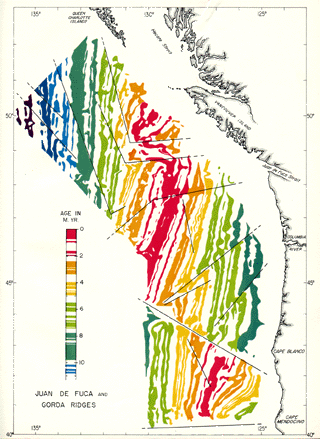Paleomagnetism and Continental Drift
By the mid twentieth century enough evidence had been amassed to begin openning the minds of many scientists to the idea that the continents could have moved across the surface of the Earth. But, armed with only circumstantial evidence and conjecture, convincing the conservative scientific majority would be nearly impossible. Proponents of Continental Drift would need hard data and that data couldn't get much harder than that found in the igneous rocks of the crust.
Igneous rocks are formed when molten rock (magma) cools and allows the mineral components to crystallize. During this cooling process iron-rich crystals that form in the liquid melt are affected by the earth's magnetic field. Much like the needle on a compass these crystals align themselves with the earth's magnetic field and, when the magma cools, permantly record the relative strength and direction of the magnetic field. This is referred to as remnant magnetism.
 |
| Image comparison of Earth's magnetic field and that of a bar magnet |
What actually drives the Earth's magnetic field is not well understood however it is believed to be generated in the liquid outer core through convective processes which create a dynamo affect. The resulting field can be thought of as a giant bar magnet running throught the center of our planet. The poles of this magnet are closely but not exactly aligned with the Earth's axis of rotation (geographic north) and over the course of thousands of years move about the pole, much like a spinning top wobbles around and around. In the last century alone the magnetic pole has migrated roughly 600 miles towards the geographic north. The strength of the magnetic field also varies over time. In fact during the 1990s scientist observed the magnetic field to weaken by 1% . All of this variation is recorded in igneous rocks around the world.
As can be seen in the image to the right, the Earths magnetic field lines are not equal; the inclination changes depending on the latitude. In general the field lines tend to become more vertical as one moves from the equator towards the poles. Since the magnetic minerals in igneous rocks record both the direction of the field lines (which way is north) but also the inclination, these minerals can be used to determine the position of the pole and the exact latitude at which the mineral formed.
In 1906, while studying the paleomagnetism of ancient rock, Bernard Brunhes made a fascinating discovery. In a series of rock Bernard noticed that some layers had minerals in which the remnant magnetism was the exact opposite orientation as todays magnetic field. From this he concluded that the Earth's magnetic field has reversed from time to time. In other words, what was magnetic north becomes magnetic south and what was magnetic south becomes magnetic north. The magnetic field as we know it today is considered normal polarity. Although the discovery that the Earth's magnetic field has reversed several times in the past seems enormous it true significance in history of continental drift will not be realized for more than 50 years.
Depiction of rock layers showing normal and reversed polarityIn the early 1950s Patrick Blankett thought he could use paleomagnetism to finally prove the theory of Continental Drift. All he would have to do is gather paleomagnetic data from rocks of known ages and he could show how the continents did indeed move across the earth. His data was perfect. It showed that over the course of 200 million years Brittain rotated through roughly 30 degrees of longitude at the same time it drifted north.
It seemed as if the data was finally found until another british scientist (S. Keith Runcorn) determined that Blankett's data did not prove continental drift. Instead of plotting the movement of the continent, like Blankett, Runcorn plotted the movementof the pole over time. This plot became known as a Polar Wandering curve and it would seem to have placed Blankett's proof on the same shelf as all other evidence for continental drift.
With all of the mounting data it was hard for anyone to ignore the possibilty of Continental Drift, but final proof was not far off. In the mid 1950s a research vessel tugging a magnetometer performed a detailed study of the magnetic intensity of the Pacific sea floor. What they found seemed puzzling. When the results were finally plotted a bizarre striped patterned emerged of alternating rows of low and high intensity magnetism. The pattern didn't seem to make sense. How could rock distributed over such relatively short distances record such drastically different magnetic record. More puzzeling was that this pattern was found in many places that were surveyed. This was not an anomaly.
 |
| Magnetic Anomalies along Pacific Ridge |
Finally in 1962 two researchers at Cambridge Univeristy, Frederick Vine and Drmmond Mathews, were perplexed over a similar survey that had just conclude over the Pacific ridge. Their survey showed the same bizarre stripe pattern and furthermore was symmetrical about the ridge. While puzzling over how this new information might fit with Harry Hess's idea of sea-floor spreading the researchers asked the most important question of all. What if the stripes of alternating intensity actually represented periods of normal and reversed magnetic polarity?
If this was the case Mathews and Vine might finally have the proof they needed. Based on Hess's earlier idea, magma welled up beneath the mid-atlantic ridge. As this magma erupted at the surface and cooled it would retain the magnetic orientation of the time (either normal or reversed). Over time as the sea floor continually spread the already cooled magma would move outward from the ridge and would be replaced by newly forming sea floor which would retain the magnetic orientation of the time when it cooled. Based on this, Mathews and Vine surmised that the low intensity magnetism simply represented time of reversed polarity.
